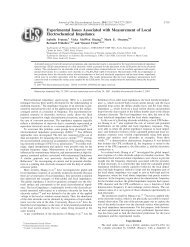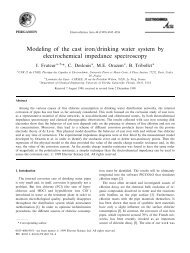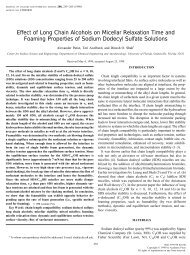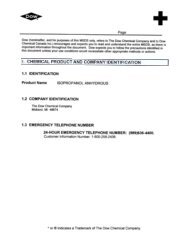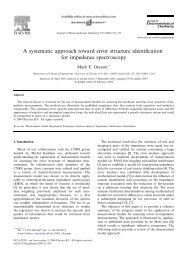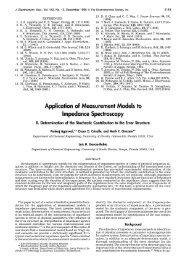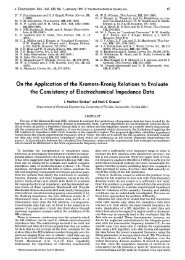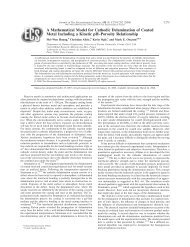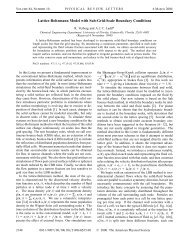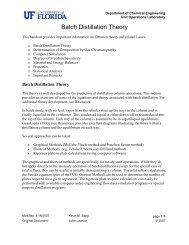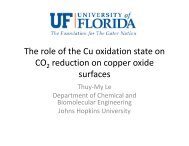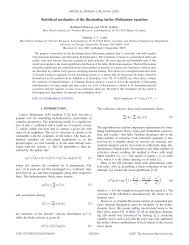W(N-pip) as a Single-Source Precursor Dojun Kim, Oh H - Chemical ...
W(N-pip) as a Single-Source Precursor Dojun Kim, Oh H - Chemical ...
W(N-pip) as a Single-Source Precursor Dojun Kim, Oh H - Chemical ...
Create successful ePaper yourself
Turn your PDF publications into a flip-book with our unique Google optimized e-Paper software.
541Downloaded 26 Oct 2009 to 128.227.139.249. Redistribution subject to ECS license or copyright; see http://www.ecsdl.org/terms_use.jspECS Transactions, 25 (8) 541-548 (2009)10.1149/1.3207637 © The Electrochemical SocietyDeposition of WN x C y from the Tungsten Piperidylhydrazido ComplexCl 4 (CH 3 CN)W(N-<strong>pip</strong>) <strong>as</strong> a <strong>Single</strong>-<strong>Source</strong> <strong>Precursor</strong><strong>Dojun</strong> <strong>Kim</strong>, a <strong>Oh</strong> Hyun <strong>Kim</strong>, a Hiral M. Ajmera, a Tim Anderson, aJürgen Koller, b and Lisa McElwee-White ba Department of <strong>Chemical</strong> Engineering, University of Florida, Gainesville, Florida 32611USAb Department of Chemistry, University of Florida, Gainesville, Florida 32611 USAThe tungsten <strong>pip</strong>eridylhydrazido complex Cl 4 (CH 3 CN)W(N-<strong>pip</strong>)(1) w<strong>as</strong> used <strong>as</strong> a single-source precursor for growth of tungstencarbonitride (WN x C y ) by metal-organic chemical vapor deposition(CVD) in H 2 carrier. Multiple spectroscopic techniques were usedfor preliminary evaluation of the suitability of 1 <strong>as</strong> a precursor andto suggest possible fragmentation pathways. The effect of growthtemperature on film microstructure, lattice parameter, averagegrain size, chemical composition, chemical bonding states, growthrate, film resistivity, and sheet resistance w<strong>as</strong> studied.IntroductionThe present challenges in microelectronic integrated circuits are their speed andreliability. To meet these challenges <strong>as</strong> device dimensions continue to shrink, theindustry is transitioning from Al to Cu interconnects in upper-level metallization toreduce RC time delays and improve reliability (1). Cu interconnects show greaterresistance toward electromigration and 40 % lower resistivity, <strong>as</strong> compared to Alinterconnects. This transition h<strong>as</strong> required the development of barrier layers to preventCu transport since the presence of Cu in Si causes serious degradation of deviceperformance <strong>as</strong>sociated with contact resistance, barrier height, p-n junctions, contactlayers, and electrical connections (2). Cu also exhibits a high diffusivity in Si (D Cu ~ 2 ×10 -5 cm 2 /s at 500 °C) and thus can affect large volumes of Si (3). Therefore, an effectiveCu diffusion barrier is required to prevent Cu transport and intermixing in Si withadjacent dielectric materials for Cu interconnect technology. Ta/TaN bilayers depositedby physical vapor deposition (PVD) are currently utilized <strong>as</strong> Cu diffusion barriers insemiconductor device technology. Limitations of PVD due to the directional nature ofdeposition, however, produce conformality challenges <strong>as</strong> the barrier thickness decre<strong>as</strong>es.WN x films show good thermal stability with Cu, acceptably low resistivity whendeposited by CVD, and re<strong>as</strong>onable behavior during chemical mechanical planarization(4). The ternary ph<strong>as</strong>e material, WN x C y , is also a promising candidate for diffusionbarrier applications (5-7). This material exhibits lower electrical resistivity, goodadhesion to Cu, very good resistance to Cu diffusion, and acceptable film growth on SiO 2 .It is noted that it is not clear from the results of this study whether the W exists <strong>as</strong> a twoph<strong>as</strong>emixture of -W 2 N and -WC 1-x or <strong>as</strong> the solid solution WN x C y . For consistency inthis report, the W material is denoted <strong>as</strong> -WN x C y .
542Downloaded 26 Oct 2009 to 128.227.139.249. Redistribution subject to ECS license or copyright; see http://www.ecsdl.org/terms_use.jspECS Transactions, 25 (8) 541-548 (2009)Experimental Procedures<strong>Precursor</strong> Synthesis<strong>Precursor</strong> 1 w<strong>as</strong> prepared <strong>as</strong> described in the literature (8).NClClNWNCCH 3ClCl1Figure 1. Structure of Cl 4 (CH 3 CN)W(N-<strong>pip</strong>) (1).Film GrowthDue to the low volatility of the precursor 1, aerosol-<strong>as</strong>sisted CVD (AACVD) w<strong>as</strong>used for film growth of this refractory metal nitride (9). The solid precursor 1 inbenzonitrile solution (8.1 mg/mL) w<strong>as</strong> filled into a syringe and pumped into a nebulizer.The nebulizer forms a precursor aerosol from the solution. A vertical, quartz cold-wallCVD reactor w<strong>as</strong> used to deposit thin films on p-type, boron-doped Si(100) substrateswith electrical resistivity of 1 - 2 -cm. <strong>Precursor</strong> aerosol in H 2 carrier w<strong>as</strong> delivered tothe substrate placed on a graphite susceptor, which w<strong>as</strong> heated by radio-frequency (rf)induction coils in the temperature range 300 to 700 °C. The operating pressure w<strong>as</strong>maintained at 350 Torr. The H 2 (99.999%, Airg<strong>as</strong>) carrier g<strong>as</strong> flow rate w<strong>as</strong> 1000 sccmand the deposition time w<strong>as</strong> 150 min.Film CharacterizationXRD (Philips APD 3720) w<strong>as</strong> used to identify the crystalline ph<strong>as</strong>e of the films andme<strong>as</strong>ure the structural properties. XPS (Perkin-Elmer PHI 5600 ESCA) w<strong>as</strong> used toidentify the chemical composition and bonding states of the elements in the film. Prior toXPS me<strong>as</strong>urements, the <strong>as</strong>-grown samples were sputter cleaned for 10 min using Ar + ionsto remove residual surface contaminants. An SEM (JEOL JSM-6335F) w<strong>as</strong> used to viewthe film thickness and surface morphology. The sheet resistance of the film w<strong>as</strong>me<strong>as</strong>ured by four-point probe (Alessi Industries).Preliminary <strong>Precursor</strong> ScreeningResults and DiscussionMultiple spectroscopic techniques were applied to evaluate the viability of 1 <strong>as</strong> aprecursor for WN x C y deposition (8). Positive-ion chemical ionization (CI) m<strong>as</strong>sspectrometry w<strong>as</strong> performed to obtain some insight into the fragmentation behavior of 1.The absence of molecular ion peaks is in good agreement with the acetonitrile ligand
543Downloaded 26 Oct 2009 to 128.227.139.249. Redistribution subject to ECS license or copyright; see http://www.ecsdl.org/terms_use.jspECS Transactions, 25 (8) 541-548 (2009)being labile. M<strong>as</strong>s envelopes containing the <strong>pip</strong>erdine moiety ([<strong>pip</strong>] + and [H 2 <strong>pip</strong>] + ) wereobserved in high abundance, suggesting that cleavage between the two hydrazido Natoms is facile under high energy conditions (ionization during MS or pyrolysis duringCVD). Studies of 1 via thermogravimetric analysis (TGA) showed a drop in m<strong>as</strong>scorresponding to loss of the acetonitrile ligand at approximately 100 °C.Film MicrostructureThe XRD spectra [Fig. 2(a)] show the evolution of film crystallinity with incre<strong>as</strong>ingdeposition temperature. The four observed reflections are well matched with a two-ph<strong>as</strong>emixture of -W 2 N and -WC 1-x ph<strong>as</strong>es or their solid solution -WN x C y with the sameface-centered-cubic (fcc) structure. The observation of film growth by X-SEM and theabsence of XRD peaks attributable to -WN x C y for films deposited from 300 to 450 °C,lead to the conclusion that amorphous material w<strong>as</strong> deposited in this temperature range.The polycrystalline peaks appearing in spectra of material deposited from 500 to 700 °Cindicate no preferred crystal orientation. Primary peaks at 37.24 and 42.98 2° areconsistent with (111) and (200) orientation, while the other two peaks at 62.58 and 74.982° originate from the (220) and (311) reflections, respectively. As the depositiontemperature incre<strong>as</strong>es to 700 °C, the (111) and (200) -WN x C y peaks sharpen. Theability to deposit amorphous films of WN x C y at low temperature is important fordiffusion barrier applications since the formation of polycrystalline films facilitatestransport of Cu across the barrier to the underlying Si via the grain boundaries.(a) Si(200) -WN xC y(111)Si(400) -WN xC y(200) Si(400) K -WN xC y(220)700 °C -WN xC y(311)(b) -W 2N(111) -WC 1-x(200)Intensity (a.u.)650 °C600 °C550 °C500 °C450 °C400 °C350 °CIntensity (a.u.) -WC 1-x(111) -W 2N(200) -W 2N(220) -WC 1-x(220) -W 2N(311) -WC 1-x(311)300 °C30 35 40 45 50 55 60 65 70 75 802 Degrees30 35 40 45 50 55 60 65 70 75 80JCPDS 25-12572 DegreesJCPDS 20-1316Figure 2. XRD spectra for films deposited from 1 on Si(100) in H 2 carrier: (a) between300 and 700 °C, and (b) standard diffraction plots for -W 2 N and -WC 1-x .<strong>Chemical</strong> CompositionXPS results for chemical composition [Fig. 3(a)] show that W, N, C, and O werepresent in the films. No Cl contamination in the deposited material w<strong>as</strong> observed withinthe detection limit of XPS (~ 1 at. %). The W level is highest for deposition temperaturebetween 450 and 500 °C, while the N, C, and O levels are relatively constant in this range.From 300 to 400 °C, the C level is below 10 at. %, with the lowest level of 6 at. % fordeposition at 400 °C. Between 500 and 700 °C, the C level incre<strong>as</strong>es gradually from 15to 67 at. %. The overall trend for C content is consistent with more rapid decompositionof hydrocarbon groups in both the precursor and the solvent <strong>as</strong> the growth temperatureincre<strong>as</strong>es, leading to incre<strong>as</strong>ed C incorporation into the film. As the depositiontemperature incre<strong>as</strong>ed from 300 to 400 °C, the N level incre<strong>as</strong>ed from 10 to 18 at. %,however, above 500 °C the N level decre<strong>as</strong>es. Typically, refractory metal nitride
544Downloaded 26 Oct 2009 to 128.227.139.249. Redistribution subject to ECS license or copyright; see http://www.ecsdl.org/terms_use.jspECS Transactions, 25 (8) 541-548 (2009)diffusion barriers show a decre<strong>as</strong>ing tendency for N incorporation with incre<strong>as</strong>ingdeposition temperature due to N 2 desorption (10). With the addition of C, there is alsoincre<strong>as</strong>ed competition from C bonding at W adsorption sites. When the depositiontemperature reaches 700 °C, the N level h<strong>as</strong> declined to ~5 at. %. Films deposited at300 °C show over 20 at. % O, which significantly decre<strong>as</strong>es to 14 at. % at 450 °C. As thedeposition temperature incre<strong>as</strong>ed from 450 to 700 °C, the O level decre<strong>as</strong>ed gradually to5 at. %. The polycrystalline microstructure shown in Fig. 2(a) becomes evident fordepositions performed at 500 °C. As the deposition temperature incre<strong>as</strong>es, the averagegrain size incre<strong>as</strong>es <strong>as</strong> well. The microstructure becomes more crystalline, whichinhibits post-growth incorporation of O into the lattice of the film (11). This result isattributed to the densification of film by grain growth between 500 to 700 °C.Intensity (a.u.)(a)C KVV1000N KVV900800O KVV700600No Cl peaksO 1s N 1s C 1sW 4f500W 4p400300Binding Energy (eV)W 4d200100700 °C650 °C600 °C550 °C500 °C450 °C400 °C350 °C300 °C0 -100Concentration (Atomic %)80706050403020100(b)250 300 350 400 450 500 550 600 650 700 750Temperature (°C)Figure 3. (a) XPS spectra for films deposited on Si(100); (b) Variation in chemicalcomposition of W, N, C, and O content in the films with deposition temperature.WNCO<strong>Chemical</strong> Bonding StatesXPS w<strong>as</strong> used to me<strong>as</strong>ure the binding energy (BE) of atoms in the films. The XPSspectra [Fig. 4(a)] reveal the evolution of the W 4f BE region <strong>as</strong> the depositiontemperature changes. The major W 4f 7/2 and W 4f 5/2 peaks at 400 °C are at 31.6 and 33.5eV, which are close to values for WC x and WN x (Table I). These two values are higherthan those for metallic W and lower than those for WO 3 . These BE values are betweenthe reference peaks of WN x and WC x , indicating W is bonded to both C and N. As thedeposition temperature rises to 700 °C, the BE incre<strong>as</strong>es to 31.8 and 33.8 eV, whichcorrespond to WC x and WN x <strong>as</strong> well. For material deposited at 300 °C, the BE moreclosely resembles that of WO 3 but shifts toward values for WC x or WN x <strong>as</strong> the depositiontemperature rises to 350 °C. This indicates a chemical bonding state shifting from WO 3dominant to WN x C y <strong>as</strong> the deposition temperature incre<strong>as</strong>es from 300 to 700 °C. Figure4(b) illustrates the change of the XPS spectra in the region of the N 1s BE <strong>as</strong> thedeposition temperature changes. The N 1s peak is observed at 397.3 eV in each spectrum,which is in the range of reported values for WN x (Table I). Hence, the N in the film isbound <strong>as</strong> WN x . N at the grain boundary can be excluded <strong>as</strong> a second peak <strong>as</strong>sociatedwith it (~399 eV) is not observed within the detection limit of XPS. The maximum Nintensity is seen in the spectra of films deposited at 400 °C, which is consistent with thehigh N level in those films.Figure 4(c) reveals the evolution of the XPS spectra in the region of the C 1s BE forseveral values of deposition temperature. The trend with incre<strong>as</strong>ing depositiontemperature is incre<strong>as</strong>ing intensity and higher BE of the C 1s peaks. Between 300 and600 °C, the BE is lower than the reported value for amorphous C, while above 600 °C,
545Downloaded 26 Oct 2009 to 128.227.139.249. Redistribution subject to ECS license or copyright; see http://www.ecsdl.org/terms_use.jspECS Transactions, 25 (8) 541-548 (2009)the BE is higher than that of WC x . Deconvolution of the broad C 1s peak at 700 °Cyields two separate peaks, which are at 283.1 and at 284.5 eV. The peaks at the lower BEare attributed to C in -WN x C y bonding states, while the peaks at higher BE areconsistent with the presence of amorphous C. For deposition at temperature higher than650 °C, a small amount of amorphous C is evident along with WC x and WN x in the film.As the deposition temperature incre<strong>as</strong>es to 700 °C, an incre<strong>as</strong>ing amount of amorphous Cco-exists with WC x in the film.Figure 4(d) displays the dependence of the XPS spectra in the region of the O 1s BE <strong>as</strong>a function of the deposition temperature. A single O peak w<strong>as</strong> observed near 530.5 eV ineach spectrum, which is consistent with the presence of WO 3 (Table I). O levels arehigher in films grown at low temperature due to diminished film crystallinity and Cincorporation. As the deposition temperature incre<strong>as</strong>es to 700 °C, the film density isincre<strong>as</strong>ed by crystallization and the grain boundaries are infiltrated by C incorporation.(a) W 4f(b) N 1s(c) C 1s(d) O 1s700 °C700 °CN(E) (a.u.)700 °C650 °C600 °C550 °C500 °C450 °C400 °C350 °C300 °CN(E) (a.u.)650 °C600 °C550 °C500 °C450 °C400 °C350 °C300 °CN(E) (a.u.)700 °C650 °C600 °C550 °C500 °C450 °C400 °C350 °C300 °CN(E) (a.u.)650 °C600 °C550 °C500 °C450 °C400 °C350 °C300 °C40383634323028402400398396394392390288286284282280278276536534532530528526524Binding Energy (eV)Binding Energy (eV)Binding Energy (eV)Binding Energy (eV)Figure 4. Change of binding energies in (a) W 4f, (b) N 1s, (c) C 1s, and (d) O 1s withdeposition temperature.Table I. Reported binding energy (BE) valuesCompound W 4f 7/2 W 4f 5/2 N 1s C1s O1s ReferencesWN x 32.7–33.6 33.3-35.8 396.2-398.2 (12-16)WC x 31.6-32.3 33.7-33.9 279.7-283.8 (15-18)WO 3 35.5-36.7 37.6-37.8 528.2-531.6 (12, 15, 16, 19, 20)Metallic W 31.2-31.7 33.4 (15-17)N at grain boundary 399.2-400.0 (19, 21)Amorphous C 284.2-285.2 (15, 16, 22)Lattice Parameter and Average Grain SizeThe lattice parameter w<strong>as</strong> determined by XRD using the 2 position of the -WN x C y (111) diffraction peaks. The lattice parameter [Fig. 5(a)] shows an incre<strong>as</strong>ingtendency <strong>as</strong> deposition temperature incre<strong>as</strong>es from 500 to 650 °C. This change isconsistent with C incorporation in the polycrystalline solid solution -WN x C y , and not atthe grain boundaries. The C level continues to incre<strong>as</strong>e with deposition temperatureabove 500 °C [Fig. 3(b)]. Between 650 and 700 °C, however, the lattice parameterdecre<strong>as</strong>es. In this range, the C level incre<strong>as</strong>es while W decre<strong>as</strong>es with almost nocompositional change in N and O [Fig. 3(b)]. The decre<strong>as</strong>e in lattice parameter between650 and 700 °C is consistent with C incorporation at the solubility limit in -WN x C y andthis limit decre<strong>as</strong>ing with incre<strong>as</strong>ing temperature (23). This conclusion is supported bythe chemical bonding states [Fig. 4(c)], where the C 1s peak in this range is shifted tohigher BE and h<strong>as</strong> a broad peak that can be deconvoluted into two separate peaksattributed to the formation of amorphous C in addition to the -WN x C y ph<strong>as</strong>e.The average grain size w<strong>as</strong> calculated using Scherrer’s equation (24). The mostdominant -WN x C y (111) diffraction peak of the four characteristic polycrystalline peaks
546Downloaded 26 Oct 2009 to 128.227.139.249. Redistribution subject to ECS license or copyright; see http://www.ecsdl.org/terms_use.jspECS Transactions, 25 (8) 541-548 (2009)w<strong>as</strong> used to determine FWHM <strong>as</strong> the reference peak in the calculation. The averagegrain size [Fig. 5(b)] incre<strong>as</strong>es between 500 and 600 °C, varying from 31 to 47 Å.4.25(a) -WC 1-x : 4.23670(b)4.2360Lattice Parameter (Å)4.214.194.174.15Average Grain Size (Å)504030204.13 -W 2 N: 4.126104.11450 500 550 600 650 700 750Temperature (°C)0450 500 550 600 650 700 750Temperature (°C)Figure 5. Change in (a) lattice parameter and (b) average grain size with depositiontemperature for polycrystalline films b<strong>as</strong>ed on -WN x C y (111) diffraction peaks.Growth RateThe growth rate is in the range of 2.7 to 29.4 Å/min, <strong>as</strong> determined by cross-sectionalSEM. For films deposited between 650 and 700 °C, the growth rate significantlyincre<strong>as</strong>ed suggesting a change in the growth mechanism at these temperatures. Thisobservation w<strong>as</strong> supported by the detection of amorphous C over 600 °C. In addition tothis high temperature growth region, the plot (Fig. 6) shows the presence of two growthregimes. The region with the shallow slope between 450 °C and 600 °C is typical of am<strong>as</strong>s transfer limited growth regime. The region with the steep slope is a kineticallycontrolled growth regime between 300 °C and 450 °C.4.0Deposition Temperature (°C)700 600 500 400 3003.53.0ln G (Å/min)2.52.01.51.00.50.01.0 1.1 1.2 1.3 1.4 1.5 1.6 1.7 1.81000/T (K -1 )Figure 6. Change in growth rate with deposition temperature.Electrical Resistivity and Sheet ResistanceFigure 7(a) shows the variation of film resistivity with deposition temperature. Thelowest resistivity is 0.9 m-cm at 550 °C and the value of film resistivity fluctuates withthe interplay of grain growth, C content, O content, and film thickness between 500 and700 °C. As shown in Fig. 3(b), an incre<strong>as</strong>e in the amorphous C level <strong>as</strong> the depositiontemperature incre<strong>as</strong>es from 650 to 700 °C results in an incre<strong>as</strong>e in electron scattering,which causes the film resistivity to incre<strong>as</strong>e. The highest film resistivity is 9.4 m-cm
547Downloaded 26 Oct 2009 to 128.227.139.249. Redistribution subject to ECS license or copyright; see http://www.ecsdl.org/terms_use.jspECS Transactions, 25 (8) 541-548 (2009)for films deposited at 350 °C. The high N level in those films is consistent withincre<strong>as</strong>ed film resistivity in the -WN x C y polycrystalline structures, which is due to thehigher resistivity for -W 2 N relative to -WC 1-x .Film resistivities obtained depend on both the sheet resistance and thickness of thefilms. The sheet resistance w<strong>as</strong> plotted with deposition temperature to decouple theinfluence of film thickness on electrical properties [Fig. 7(b)]. The sheet resistanceincre<strong>as</strong>es sharply with deposition temperature from 370 / at 300 °C to 1480 / at350 °C. This incre<strong>as</strong>e is consistent with oxide formation. As deposition temperatureincre<strong>as</strong>es to 550 °C, the sheet resistance decre<strong>as</strong>es to 60 / due to lower O and higher Ccontent. The value of the sheet resistance fluctuates with incre<strong>as</strong>ing depositiontemperature above 550 °C, but eventually become stable near 70 / at 700 °C.10(a)2,000(b)Film Resistivity (m-cm)8642Sheet Resistance (/square)1,5001,00050000250 300 350 400 450 500 550 600 650 700 750250 300 350 400 450 500 550 600 650 700 750Temperature (°C)Temperature (°C)Figure 7. Change in film resistivity and sheet resistance with deposition temperature.ConclusionsThe tungsten <strong>pip</strong>eridylhydrazido complex Cl 4 (CH 3 CN)W(N-<strong>pip</strong>) (1) w<strong>as</strong> used <strong>as</strong> <strong>as</strong>ingle-source precursor for film growth of WN x C y to investigate film properties relevantto diffusion barrier applications. XRD results suggest that films deposited at temperaturebelow 500 °C are X-ray amorphous and films deposited at higher temperature arepolycrystalline. The XPS data on the W 4f bonding state are consistent with W present inWN x C y and WO 3 . For films deposited at the low end of the temperature range, WO 3predominates and <strong>as</strong> the deposition temperature incre<strong>as</strong>es, WN x C y becomes the dominantW species. XRD results, however, do not indicate any WO 3 peaks. The XPS data on theN 1s bonding state suggest that N is present in WN x . while results on the C 1s bondingstate indicate that C is present in WC x and <strong>as</strong> amorphous C. For depositions attemperature higher than 650 °C, amorphous C co-exists with WC x . The XPS data on theO 1s bonding state suggests that O is present in WO 3 and the O levels are the highest forgrowth temperature below 400 °C. As the deposition temperature varies, the film growthrate incre<strong>as</strong>es from 2.7 to 29.4 Å/min, with the transition from a kinetically controlledgrowth regime to a m<strong>as</strong>s transfer controlled regime occurring near 550 °C. Filmresistivity changes with the interplay of grain growth, C and O content, and filmthickness. Further diffusion barrier testing and film characterization are in progress.AcknowledgmentsWe would like to thank the National Science Foundation for support under NSF-CRCGrant CHE-0304810. We also would like to thank the Major Analytical InstrumentationCenter (MAIC) at the University of Florida for <strong>as</strong>sistance with XPS, XRD, and SEM.
548Downloaded 26 Oct 2009 to 128.227.139.249. Redistribution subject to ECS license or copyright; see http://www.ecsdl.org/terms_use.jspECS Transactions, 25 (8) 541-548 (2009)References1. E. Kolawa, P. J. Pokela, J. S. Reid, J. S. Chen and M. A. Nicolet, Appl. Surf. Sci.,53, 373 (1991).2. M. Wittmer, Appl. Phys. Lett., 36 (6), 456 (1980).3. A. A. Istratov, J. Electrochem. Soc., 149(1), G21 (2000).4. N. Gonohe, Mater. Trans., 43 (7), 1585 (2002).5. K.-E. Elers, V. Saanila, W.-M. Li, M. Soininen, J. T. Kostamo, S. Haukka, J.Juhanoja and W. Besling, Thin Solid Films, 434 (1-2), 94 (2003).6. S. Smith, W.-M. Li, K.-E. Elers and K. Pfeifer, Microelectron. Eng., 64 (1), 247(2002).7. A. M. Hoy<strong>as</strong>, J. Schuhmacher, C. M. Whelan, T. F. Landaluce, D. Vanhaeren andK. Maex, J. Appl. Phys., 100 (11) 114093-1 (2006).8. J. Koller, H. M. Ajmera, K. A. Abboud, T. J. Anderson and L. McElwee-White,Inorg. Chem., 47, 4457 (2008).9. L. McElwee-White, Dalton Trans., (45), 5327-5333 (2006).10. H. P. Kattelus, E. Kolawa, K. Affolter and M. A. Nicolet, J. Vac. Sci. Technol. A,3 (6), 2246 (1985).11. P. J. Pokela, C. K. Kwok, E. Kolawa, S. Raud and M. A. Nicolet, Appl. Surf. Sci.,53, 364 (1991).12. H. L. Zhang, D. Z. Wang and N. K. Huang, Surf. Coat. Technol., 115 (2-3), 140(1999).13. Y. G. Shen and Y. W. Mai, Mat. Sci. Eng. B-Solid, 76 (2), 107 (2000).14. J. S. Lee, C. S. Park, J. Y. Kang, D. S. Ma and J. Y. Lee, J. Vac. Sci. Technol. B, 8(5), 1117 (1990).15. C. D. Wagner, W. M. Riggs, L. E. Davis, J. F. Moulder and G. E. Muilenberg,Handbook of X-ray Photoelectron Spectroscopy, Perkin-Elmer Corporation, EdenPrairie, MN (1978).16. J. F. Moulder, W. F. Stickle, P. E. Sobol and K. D. Bomben, Handbook of X-rayPhotoelectron Spectroscopy, Physical Electronics, Eden Prairie, MN (2000).17. R. J. Colton and J. W. Rabalais, Inorg. Chem., 15 (1), 236 (1976).18. G. Leclercq, M. Kamal, J. M. Giraudon, P. Dev<strong>as</strong>sine, L. Feigenbaum, L.Leclercq, A. Frennet, J. M. B<strong>as</strong>tin, A. Lofberg, S. Decker and M. Dufour, J.Catal., 158, 142 (1996).19. T. Nakajima, K. Watanabe and N. Watanabe, J. Electrochem. Soc., 134 (12), 3175(1987).20. P. J. C. Chappell, M. H. Kibel and B. G. Baker, J. Catal., 110, 139 (1988).21. M. Nagai and K. Kishida, Appl. Surf. Sci., 70-1, 759 (1993).22. V. Crist, Handbook of Monochromatic XPS Spectra: The Elements and NativeOxides, John Wiley & Sons, New York, NY (2000).23. O. J. Bchir, S. W. Johnston, A. C. Cuadra, T. J. Anderson, C. G. Ortiz, B. C.Brooks, D. H. Powell and L. McElwee-White, J. Cryst. Growth, 249, 262 (2003).24. B. D. Cullity and S. R. Stock, Elements of X-ray diffraction, 3rd ed., Prentice Hall,Upper Saddle River, NJ (2001).



